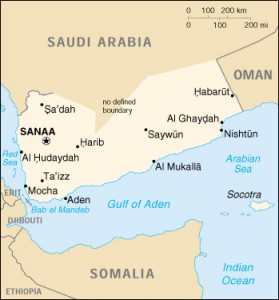The true casualty figures of US drone strikes in Yemen “don’t always match up” with “the official version of events,” according to an investigation by National Public Radio.
 Visiting the site of an airstrike in the southern town of Jaar that took place in May, reporters interviewed eye-witnesses who said an American aircraft destroyed a house on the main street, killing one man inside. But when dozens of civilians rushed to the scene, another strike hit.
Visiting the site of an airstrike in the southern town of Jaar that took place in May, reporters interviewed eye-witnesses who said an American aircraft destroyed a house on the main street, killing one man inside. But when dozens of civilians rushed to the scene, another strike hit.
“We didn’t think it would come back,” one witness told NPR. “Suddenly we see it come back…and shoot again.” The second strike killed at least 12 people instantly. “They were cut … in pieces,” he says.
“A wall where the second strike hit is still covered with blood,” the reporter says.
This practice of “follow-up strikes” resembles policies in the drone war in Pakistan, wherein targets are often hit twice, after rescuers have had a chance to swarm to the site. Citing reports that the US has conducted follow-up drone strikes aimed at people coming to the strike scene to rescue the injured, UN special rapporteur on extrajudicial, summary or arbitrary execution Christof Heyns said last month, if it is true, “those further attacks are a war crime.”
Follow-up strikes are apparently a hallmark of the so-called “signature strikes” President Obama recently approved for use in Yemen. Signature strikes are those that target unidentified individuals in unidentified groups that are not engaged in direct hostilities with the US, nor are they presenting any imminent threat the administration is willing to establish.
“Our lives are valueless in the eyes of our government,” said one resident of Jaar at the time of the strikes, “and that is why civilians are being killed without a crime.”
The Bureau of Investigative Journalism has recorded up to 746 people killed in US strikes in Yemen since 2002, with as many as 117 confirmed civilians, 24 of them children. Neither the US government, nor the Yemeni government will comment on these airstrikes or the casualties associated with them.
In a hospital near Jaar, NPR spoke to a young boy who was injured and badly burned from the May airstrike. Another man Ali Al Amoudi said a strike “hit his house and three others just a few weeks ago in the town of Shaqra, just down the road from Jaar. His 4-year-old son and 6-year-old daughter were hit. They died in his arms on the way to the hospital.”
Saleh Qaid Toayman was a Yemeni who was killed in an airstrike in October and is supposed to have “fought in Afghanistan in the 1980s with men who would later join al-Qaida,” NPR reports. His son, Azzedine, was nearby when an airstrike killed him and another of his sons.
“I went to see my father and my brother. They were scattered into pieces.” Azzedine and his other surviving siblings “say they want to fight against those who killed their father, namely against America.” Saleh’s eldest son has already formally joined Ansar al Sharia, an al-Qaeda-linked group, to avenge his father’s death.


